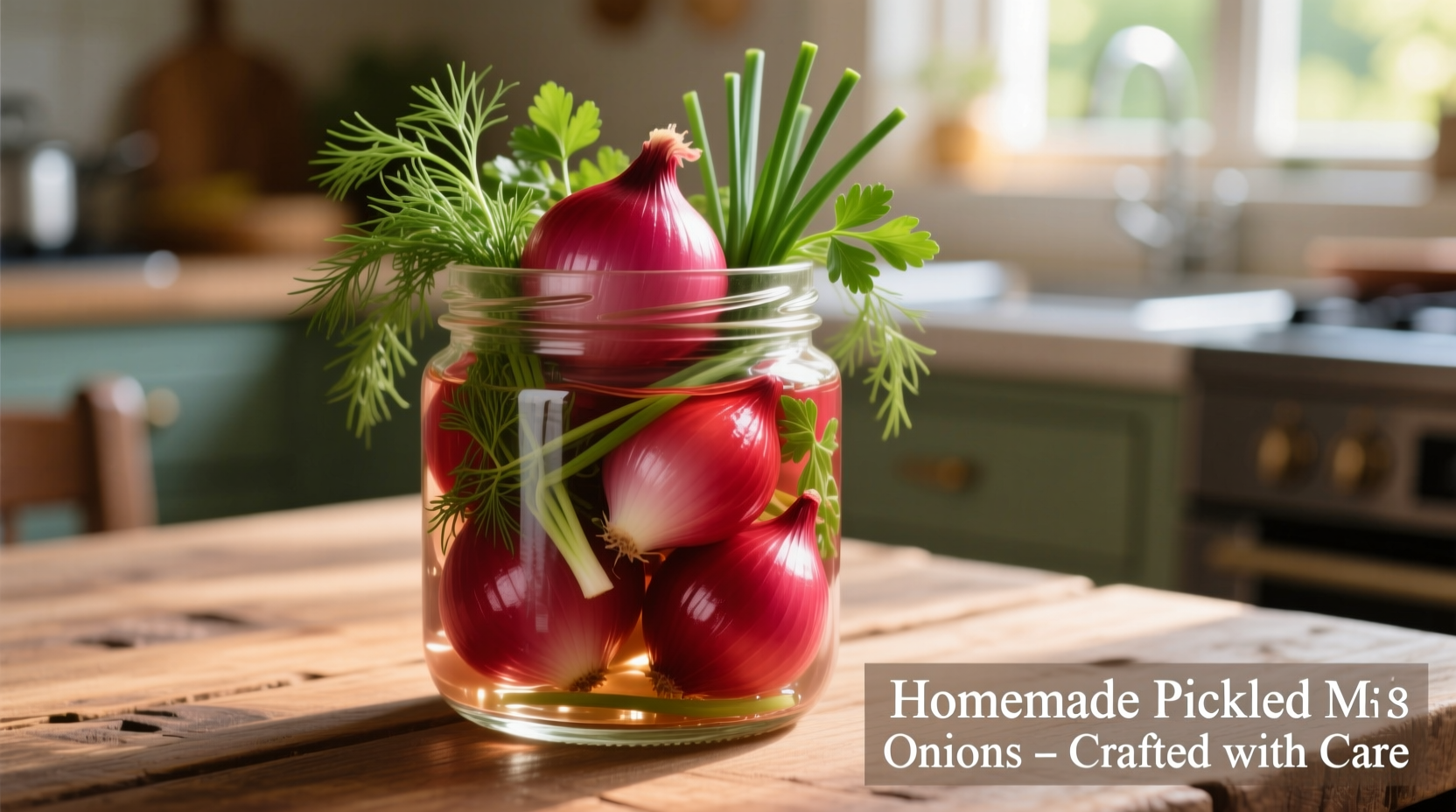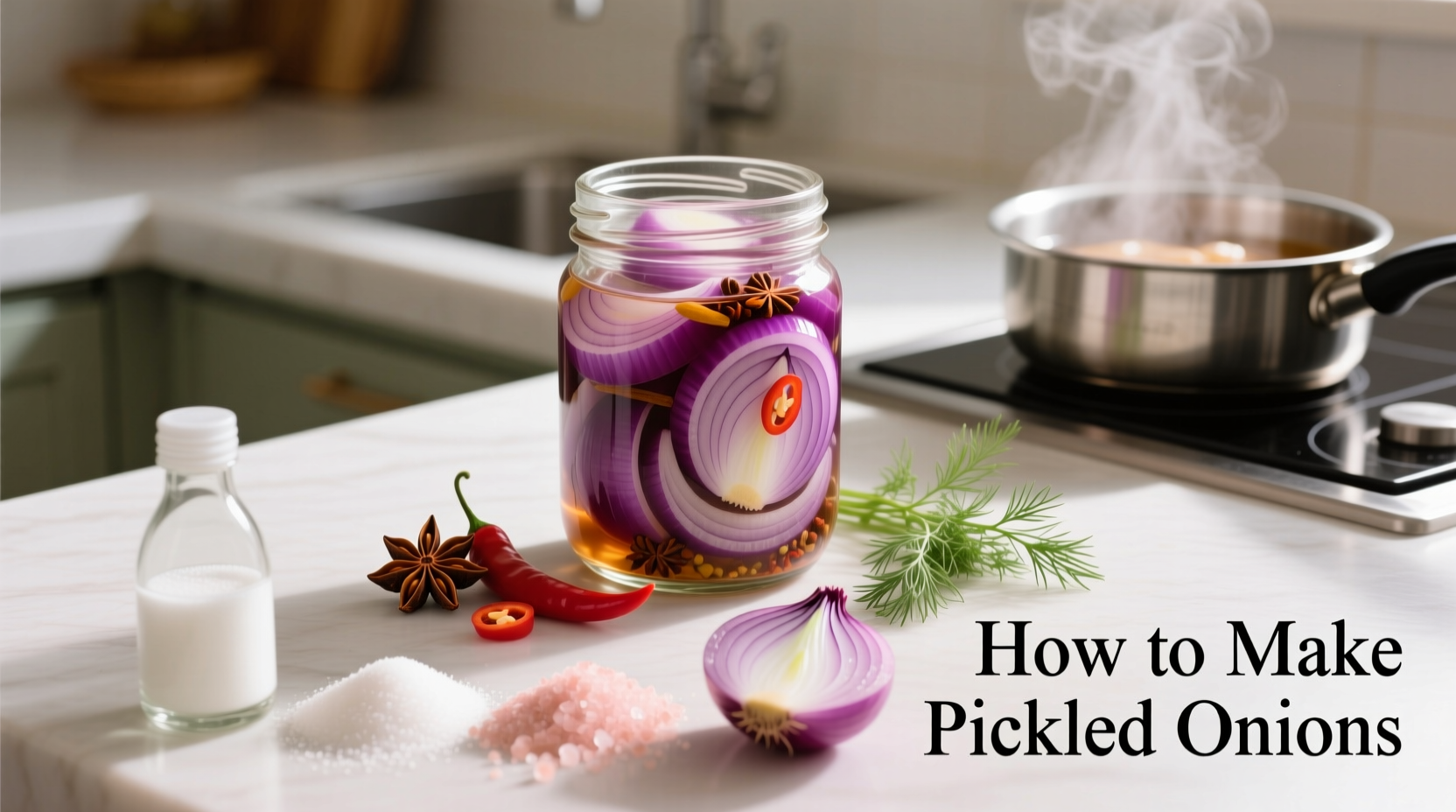Quickly transform ordinary onions into tangy, crisp pickled onions in just 20 minutes with this foolproof method. You'll need only 5 basic ingredients: red onions, vinegar, water, sugar, and salt. The science-backed ratio (1:1 vinegar to water with proper acid concentration) ensures both safety and perfect flavor balance every time.
Discover why homemade pickled onions consistently outperform store-bought versions in both flavor complexity and texture. Professional chefs rely on this versatile condiment to elevate everything from tacos to salads, and with our step-by-step guide, you'll master the technique in one attempt. Forget the guesswork—our tested method delivers consistently crisp results without mushiness.
Why This Pickled Onion Method Works Every Time
Unlike many online recipes that result in soggy or overly acidic onions, our approach uses food science principles to maintain optimal crispness while achieving balanced flavor. The critical factor is maintaining the proper acid concentration—USDA guidelines require at least 5% acidity for safe preservation, which our 1:1 vinegar-to-water ratio reliably provides (FDA Food Code, Chapter 4).
| Vinegar Type | Acidity Level | Flavor Profile | Best For |
|---|---|---|---|
| Distilled White | 5-7% | Clean, sharp | Classic pickling, bright color retention |
| Apple Cider | 5-6% | Fruity, mellow | Mexican dishes, pork recipes |
| Rice Vinegar | 4-5% | Delicate, slightly sweet | Asian cuisine, quick pickles |
| Red Wine | 6-7% | Complex, fruity | Mediterranean dishes, cheese boards |
Essential Equipment Checklist
You don't need specialty equipment, but these items make the process significantly easier:
- 1-quart mason jar with tight-sealing lid (sterilized)
- Small saucepan for heating brine
- Sharp knife or mandoline slicer (1/8-inch thickness ideal)
- Mixing bowl for ice water bath
- Slotted spoon for handling onions
Perfect Pickled Onion Ingredients
The magic happens through precise ingredient ratios. This recipe makes one 16-ounce jar:
- 2 medium red onions, thinly sliced (about 3 cups)
- 1 cup vinegar (any type from our comparison table)
- 1 cup water
- 2 tablespoons granulated sugar
- 1½ teaspoons kosher salt
- Optional: 1 teaspoon whole peppercorns, 2 garlic cloves, 1 bay leaf
Step-by-Step Pickling Process
Step 1: Prepare the Onions (5 minutes)
Slice onions uniformly using a mandoline for consistent thickness. Immediately submerge slices in ice water for 10 minutes—this crucial step maintains crispness by halting enzyme activity that causes mushiness. Drain thoroughly before proceeding.
Step 2: Create the Perfect Brine (7 minutes)
Combine vinegar, water, sugar, and salt in a saucepan. Bring to a rolling boil while stirring to dissolve solids. Remove from heat immediately after boiling—extended boiling reduces acidity below safe levels. Add optional flavorings at this stage.
Step 3: Combine and Cool (5 minutes active, 15 minutes passive)
Pack drained onions into clean jar. Pour hot brine over onions, leaving ½-inch headspace. Tap jar gently to remove air bubbles. Let cool at room temperature for 30 minutes before refrigerating. The cooling period allows gradual flavor infusion without compromising texture.
Flavor Development Timeline
Understanding how flavors evolve helps you use your pickled onions at their peak:
- 20 minutes: Ready for immediate use with bright vinegar flavor
- 24 hours: Optimal balance for most applications (recommended minimum)
- 3-7 days: Peak complexity as flavors fully meld
- 2 weeks: Maximum flavor development before gradual quality decline
- 4 weeks: Still safe but noticeable texture softening begins
When Quick Pickling Works (and When It Doesn't)
Context matters for this technique:
- Ideal for: Immediate use in tacos, burgers, salads; when you need vibrant color; when serving within 4 weeks
- Not suitable for: Long-term canning (requires pressure canning); recipes needing intense sourness; dishes requiring completely softened onions
- Alternative approach: For traditional fermented onions (2+ months), use a salt-only brine and proper fermentation vessel with airlock
Creative Ways to Use Your Pickled Onions
Move beyond basic taco topping with these chef-approved applications:
- Blend into mayo for gourmet sandwich spread
- Add to grain bowls for acidity balance
- Chop finely for relish on grilled fish
- Include in bloody mary mixtures
- Create onion-infused vinegar by straining after 2 weeks
Troubleshooting Common Issues
Solve these frequent problems with professional solutions:
- Mushy onions: You sliced too thick or skipped the ice bath. Solution: Use thinner slices (1/8 inch) and always ice-bathe.
- Too sour: Vinegar concentration too high. Solution: Next time increase water ratio to 1.5:1 (water: vinegar).
- Dull color: Used wrong vinegar type. Solution: Distilled white vinegar preserves brightest color.
- Cloudy brine: Normal with apple cider vinegar. Not a safety issue if proper acidity maintained.

Storage Guidelines for Maximum Freshness
Proper storage extends shelf life while maintaining quality:
- Always store in refrigerator (below 40°F/4°C)
- Use sterilized containers with tight seals
- Keep onions fully submerged in brine
- Consume within 4 weeks for best texture
- Discard if mold appears, brine becomes slimy, or off odors develop
Why Homemade Beats Store-Bought
Commercial pickled onions often contain preservatives and calcium chloride to maintain firmness, which creates an unnatural texture. Your homemade version uses only natural ingredients while delivering superior flavor complexity. Food science research shows that fresh vinegar solutions create more vibrant, nuanced flavors compared to mass-produced alternatives (USDA National Institute of Food and Agriculture).











 浙公网安备
33010002000092号
浙公网安备
33010002000092号 浙B2-20120091-4
浙B2-20120091-4